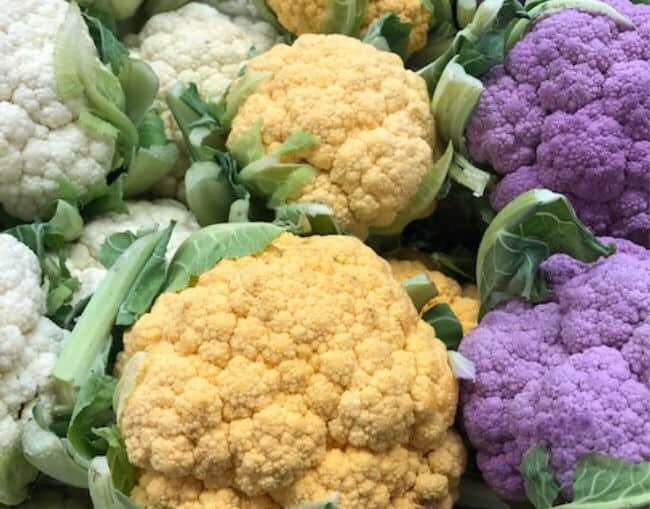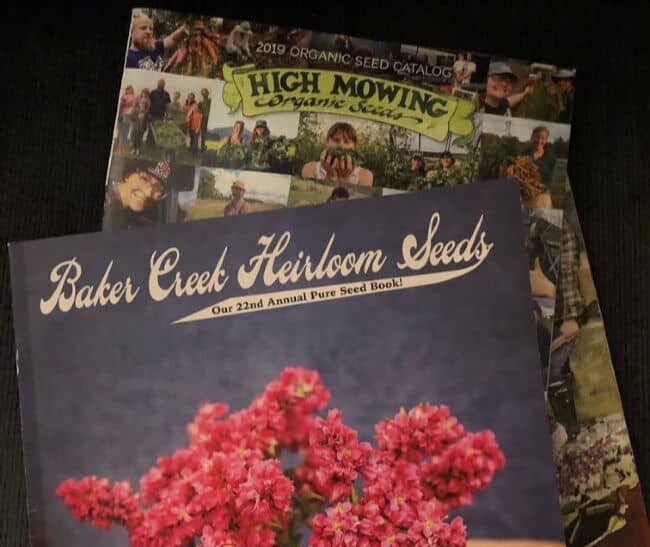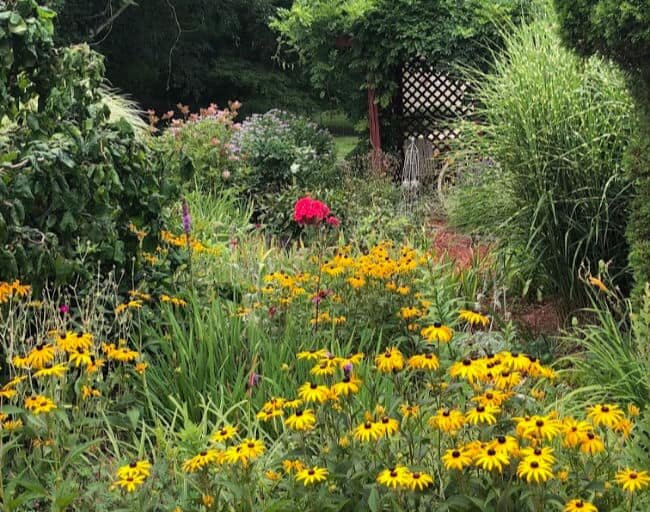Getting Your Garden Ready for Spring
Yes, I know, it’s only January, but spring will be here before you know it, so you’ll want to start planning your garden now. With spring comes warmer weather, sunshine and GARDENING! Can you tell I’m excited?
You’ll find as you read this post that it’s fairly general. I’m not going to get into the specifics of how to care for certain plants and how to prepare your garden for planting and all of that.
The specifics will be coming your way over the next couple of months, so be sure to stay tuned and subscribe to receive updates, if you haven’t already. You can check out what’s available in my Resource Library and sign up if you’d like by clicking here.

Space Considerations
So, where to start? First, do an honest evaluation of the space you have for gardening. If you have an apartment balcony and that’s it, your plans are going to look very different from someone who has 3 1/2 acres. You can still garden though. In fact, I have a post on planting a vegetable garden entirely in containers. Yes, it can be done!

It’s approximately 20 x 40 feet. Also, notice the pot of nasturtiums and other
pollinator-enticing flowers in the lower left. More on that below.
Light (Sun) Considerations
Also, evaluate how much sun your space gets. Really keep an eye on it for a full day. The sun is, of course, at a different angle this time of year than it will be in the summer, but you should be able to get a fairly good idea.
Keep in mind that most vegetables and fruits require quite a bit of sun every day (often 6-8 hours). If you have a very wooded area, you’ll need to look into planting varieties that don’t need as much sun.
OK, you’ve figured out your space. Now, what do you want to grow? Flowers, veggies, fruits, a little of each? I’m going to split things up here and talk about fruits and veggies separately from flowers.
Fruits and Veggies
Plant some Flowers for the Pollinators!
So, you’ve decided you want to grow fruits and/or vegetables this year. My first piece of advice? Grow flowers too!
What??!! I just got done telling you I want to grow fruits and veggies, you say. I know, I know, but here’s the thing. Those fruits and veggies (for the most part) need pollinators to do their work so you end up with a harvest at the end of the season. How are you going to attract the greatest number of pollinators? With flowers!
You don’t have to go crazy and plant an entire flower garden. What I like to do (and I also have MASSIVE flower gardens) is plant a couple of pots of flowers and intersperse them in my veggie garden.
My favorites are marigolds, nasturtiums and various herbs (mint, rosemary, basil and oregano are my go-to’s, but there are many more to choose from). The bonus with herbs is that you get a harvest from them all season too!

This post contains affiliate links. When you make a purchase through one of these links, I earn a small commission. This does not affect your purchase price.
Annuals v. Perennials for Pollinators
If you’re choosing flowers solely to attract pollinators, choose annuals. They tend to flower repeatedly and often throughout the season, more so than perennials, and this is what you want for those bees and butterflies.
If you’re looking to attract bees, look for long, trumpet-shaped flowers (like nasturtiums and fuschias). If you’re looking to attract butterflies, you’ll want broad, flat flowers they can land on (marigolds, sunflowers and coneflowers are great. Yes, coneflowers are perennials but they bloom a LOT so they work well).
One caution: I just read today that some sunflowers are being bred to be pollenless. You obviously don’t want these. Your best bet would be to order from a company like Baker Creek Seeds or Seeds Now that use open-pollinated, organic seeds. You’re not going to find pollenless sunflowers from either of these companies.
Depending on what part of the country (or world) you live in, your go-to flowers and herbs will be different than mine here in Zone 6b. Go to your local garden center and they should be able to help you pick some varieties that will grow well in your area.
Veggie Varieties
Ok, now on to the vegetables and fruits! Think about what kinds of veggies and fruits your family enjoys. I know that sounds basic, but you’d be shocked at the number of people I’ve talked to who are trying to give away mountains of eggplant because they grew it and no one in their family eats it. Ummm, why did you grow it then?
What do you love to eat? What do your spouse, kiddos and extended family like? If you’re new to food gardening, make a list of no more than 6 to 8 veggies and fruits that you’d like to grow.
If you’ve read my Guide for New Gardeners post, I talk about keeping it simple, sweetheart! Trust me when I say that, if you’ve not gardened a lot or never grown food crops before, sticking with 6 to 8 crops your first year is a mighty fine idea. Otherwise, you’re going to get frustrated and quit and you don’t want to do that, now do you?
In this area, asparagus, zucchini, cucumbers, radishes, lettuce, tomatoes, potatoes, sweet potatoes (with some help since our growing season is a teensy bit short for them), peas, green beans and peppers all tend to be fairly easy to grow.
Again, you may find there are others you can grow that I can’t, or some that might not do so well in your area. For instance, if you’re well south of me, peas and lettuce might be an issue, as they both like cooler weather. BUT, you might be able to grow them in the winter if you’re far enough south, something I can’t even contemplate.
Update: I’ve started a Crop of the Week post to help you with specifics on certain common veggie plants for your garden. Here’s the first one: Growing Peas Successfully. I’ll be talking about a new crop each week (on Friday). If you’re an email subscriber, you’ll also have access to a Crop of the Week Cheat Sheet (available in the Subscribers Resource Library) so be sure to head over here to sign up (no spam, I promise!)

Fruit Varieties
What about fruit plants? Around here, melons, strawberries, blueberries, raspberries, blackberries and rhubarb all do well. I don’t know if you’d consider rhubarb a fruit, but I don’t really see it as a veggie, so I put it here. For my zone, rhubarb is about as easy care as you can get. Nothing eats it and it just keeps growing and growing.
I’ve also had huge success with raspberries and not had any trouble with them being eaten by critters or birds. I personally prefer black raspberries, so that’s what I grow, although I’m going to give gold (yellow) raspberries a try this year. Here’s the lowdown on growing raspberries for you.
Raspberries and blackberries are EXTREMELY thorny, so if you have children or pets that run around your yard, you may want to situate the bushes somewhere that no one is going to run into them.
Melons of all kinds do well here too. Just remember that watermelons and cantaloupes need quite a lot of space, as they’re vining plants. The cool thing with them, though, is that unless you’re growing the monster 75 pound watermelon variety, you can grow them vertically. Have you signed up for my email list so you can get my easy DIY garden trellis plans in the resource library yet? You can do that here.
With my trellis, you can grow peas, green beans, melons, cucumbers and other vining plants vertically and save huge amounts of space in your garden. And as a bonus, the trellis can be built very inexpensively and in just one afternoon.
So, you’ve picked the crops you want to grow. Now what? The next question you should ask yourself is whether you want to start your veggies from seed or buy transplants.
Buying Transplants
The advantage to buying transplants is obvious: You get plants that are already growing and healthy and all you have to do is plant them in your garden at the appropriate time. The disadvantage? They’re more expensive than starting from seed and you may have trouble finding exactly the varieties you want.
However, again, if you’re brand new to gardening, transplants are a great way to go. I used transplants for quite a few years until I felt really comfortable trying to grow from seed, and even then, I had more failures than successes on my first few tries.
Starting Plants from Seed
Starting from seed does have some major advantages. First, it’s much cheaper than buying all those plants. I just bought 18 different varieties of seeds from Baker Creek Seeds (don’t judge, I’ve been gardening for 25+ years and might be a teensy bit obsessed) and it only cost me about $50.
Keep in mind that many of those seed packets contain 50 or 100 or more seeds, so I’ll be using them for several years. Major bang for my buck!
Starting from seed also allows you to pick exactly the variety you want. Check out any seed catalog (here’s a link to three of my favorites: Seeds Now, Baker Creek Seeds and High Mowing Organics) and you’ll find a dizzying array of varieties. (Ooooh, and check out these Brad’s Atomic Grape tomatoes! I totally ordered these and can’t WAIT to grow them. They are sooooo cool!)

Starting Seeds Indoors
The disadvantage of starting from seed (if what you’re starting can’t be started directly out in the garden) is that you must have room in your house to grow them. If you’re only doing a few, a sunny windowsill is certainly adequate.
However, if you’re slightly ~ahem~ obsessed, like yours truly, that won’t be enough. I have a room devoted to my plants, with grow lights everywhere I could manage to find space to hang them. If your basement is relatively warm, you can hang a few lights down there and do that as well.
I’ve written two blog posts on starting seeds indoors to help you out: Five Essentials for Successful Seed Starting and Eight Simple Steps for Successful Seed Starting. These also have a printable cheat sheet available in the Subscribers’ Resource Library.
Flowers
Ah, flowers. I miss flowers…..Sorry, it’s that whole I hate winter thing again. Here we go. Let’s talk about what you can do to plan a flower garden.
Site Considerations
Many of the things I mentioned above also apply to flowers. You’ll want to do an evaluation of your garden site. How big is it? How much sun does it get? The nice thing with flowering plants is that there are plants for every sun exposure, from full sun all the way to full shade.
When you look at a plant care tag, it will tell you what sun exposure the plant likes best. Many plants are fairly forgiving when it comes to this, but you certainly don’t want to put a full sun plant in full shade. At best, you’ll get no flowers. At worst, you’ll get dead plants!
If you do have full, deep shade, your quest for flowers is going to be more difficult. There aren’t a lot of plants out there that flower in full shade, but that just gives you the opportunity to be a bit more inventive.
There are tons of plants that like shade and have amazing foliage. Hostas, for instance, are very easy to grow and the variety is staggering. Check out this company’s sales page to see just how many hostas there are! Don’t resign yourself to boring just because you have shade. It’ll just take a little more research on your part.

What Will Grow in your Area?
Another consideration with flowers is that, if you’re planting perennials, you need to make sure they’ll grow in your area. As I’ve mentioned, I’m in hardiness Zone 6b. If you don’t know your hardiness zone and you live in North America, you can find it here. Just plug in your zip code towards the top of the page and you’ll get your zone.
If you live in the southern United States, your heat zone is another consideration. You can find that here.
This is one area where you really need to follow the guidelines, whether for hardiness or heat zones. Most plants don’t do well if they’re out of their zones.
If you’re a really experienced gardener and you know how to protect plants during the winter and that type of thing, you might be able to stretch your zone by one either way, but I wouldn’t recommend it.
There are enough plants available that will grow in your zone that you don’t have to mess around with plants that probably aren’t going to make it anyway (although admittedly, I’ve fallen in love with crape myrtle trees and would LOVE to try to grow one here…..)
Annual Flowers
With annuals, zones don’t matter, as they will only grow for one season anyway. Here, you can go wild and have fun!
I tend to gravitate towards perennials just because once I’ve planted them, they come back over and over, but annuals are wonderful for season-long color! There’s nothing better than a big group of sunflowers or a flower bed full of pansies, snapdragons and fuschias!
Annuals are a lot of fun, and may be better for beginners as they don’t need as much care as perennials.
Some annuals will even reseed and come back the next year. Again, this depends on your zone and how hardy they are, but it can happen. I’ve had everything from portulaca to cleome come back for me, so you might get a nice surprise.
Why Not Plant some Natives?
**Throat clearing** I’m going to step up on my soapbox for a moment right now, so please forgive me. If you’re going to be planting flowers anyway, please think about planting those that are native to your area. It is so much better for the pollinators to have native plants.
I’m not saying you can’t plant anything else, I have a mix of both native and nonnative plants, but I’ve noticed that since I’ve planted more native plants, I have more bees and butterflies.
In particular, I have butterfly weed and milkweed and for the first time this past summer, I had monarch caterpillars. I’ll be experimenting with raising the caterpillars this summer (another future blog post!), but you don’t need to go that far. Just planting natives will make a big difference.
Dill is also a good plant to have, as it’s the host plant to swallowtail caterpillars. I’ve had them for years and they are such beautiful creatures! *I’m coming back off my soap box now.*

Planting for Pollinators
Again, if you’re planting for butterflies, large flat flowers are best. For bees and hummingbirds, trumpet-shaped flowers are what you want. Apparently, butterflies have fairly poor eyesight, so planting a large group of a single type of flowering plant is better than planting one or two here and there all over your yard.
Keep in mind that many annuals are very sensitive to frost. You’re going to be seeing lots and lots of plants at your local garden center LOOOOONG before you can actually plant them outside safely.
I really don’t know why they do that, other than maybe to increase sales after people buy them, take them home and plant them. A frost comes, they get killed, and the customers have to go back to the garden center and buy more!
One notable exception to this is the pansy. You’ll see pansies out for sale very early (March here in Zone 6b), but you can actually plant them. They’re fairly impervious to cold and snow and are more likely to die out once the weather gets hot during the summer.
I love to go get a flat of cheerful, colorful pansies and plant them in big pots right outside my front door while there’s still snow on the ground. They make me happy!

I hope this post has been helpful for you as you begin planning your summer garden. As I mentioned, email subscribers get ALL THE FREEBIES. Additionally, future blog posts will have more detailed info too.
You can also check out a couple of books I’ve found to be particularly helpful while gardening. They’re all available on Amazon:
- Rodale’s Ultimate Encyclopedia of Organic Gardening
- The Organic Gardening Bible
- Vegetable Gardener’s Bible
If you have specific questions you’d like to see answered in the future, please drop me some comment love or a quick email ([email protected]) and I’ll see what I can do.
If you’re enjoying my posts, please share me with all your gardening friends. You can find me on Facebook (please come on over and like my page anytime) and Instagram. Feel free to pin the pictures below on Pinterest too (and I’d love if you’d do that, it would really help me out!).
Posts Related to Planning Your Spring Garden
- Growing A Vegetable Garden in Containers
- Tips For Beginning Gardeners
- Soil Organic Matter
- Reading a Seed Packet
- Growing Garden Peas
- Five Essentials for Seed Starting
- Eight Steps for Successful Seed Starting
- Resource Library
As always, smile and have a crazy organic day!




